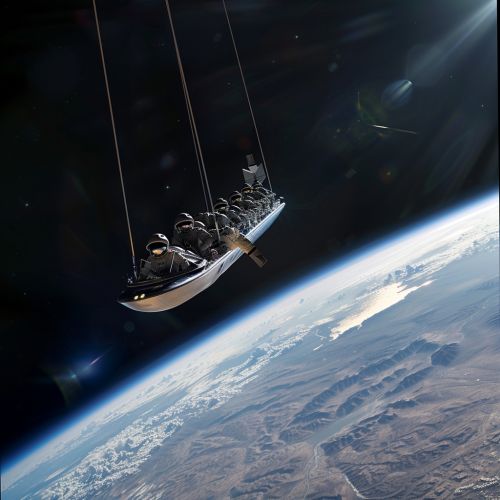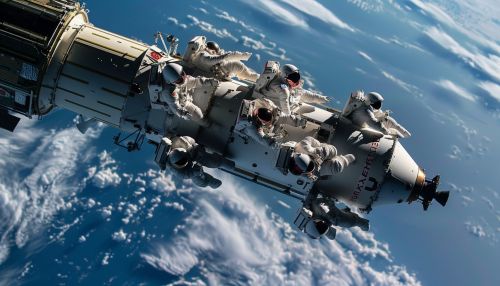Space commercialization
Introduction
Space commercialization refers to the use of space and its resources for commercial purposes. This includes a broad range of activities such as satellite communications, space tourism, space mining, and the development of space habitats. The commercialization of space has been driven by advancements in technology, reductions in launch costs, and increasing interest from private companies and investors. This article delves into the various aspects of space commercialization, exploring its history, current trends, challenges, and future prospects.
History of Space Commercialization
The commercialization of space began in the mid-20th century with the launch of the first artificial satellite, Sputnik 1, by the Soviet Union in 1957. This event marked the beginning of the space age and spurred interest in the potential commercial applications of space technology. The United States followed with the launch of Explorer 1 in 1958, and the establishment of NASA in the same year.
The 1960s and 1970s saw the development of satellite communications, with the launch of the first commercial communications satellite, Telstar 1, in 1962. This period also witnessed the growth of the satellite television industry and the use of satellites for weather forecasting and navigation.
The 1980s marked a significant turning point with the introduction of the Space Shuttle program, which aimed to reduce the cost of access to space. The commercialization of space gained further momentum in the 1990s with the emergence of private space companies such as SpaceX and Blue Origin.
Satellite Communications
Satellite communications have been one of the most successful and enduring aspects of space commercialization. Satellites are used for a wide range of applications, including television broadcasting, internet services, and mobile communications. The development of geostationary orbit satellites has been particularly important, as these satellites can provide continuous coverage to specific regions of the Earth.
The satellite communications industry has seen significant growth in recent years, driven by increasing demand for high-speed internet and mobile services. Companies such as Iridium Communications, Inmarsat, and SES S.A. have been at the forefront of this industry, providing a range of satellite-based services to customers around the world.
Space Tourism
Space tourism is an emerging sector within the space commercialization landscape. It involves the provision of commercial space travel experiences to private individuals. The concept of space tourism gained widespread attention in 2001 when American businessman Dennis Tito became the first space tourist, traveling to the International Space Station (ISS) aboard a Russian Soyuz spacecraft.
Several companies are currently developing space tourism services, including Virgin Galactic, Blue Origin, and SpaceX. Virgin Galactic, founded by Richard Branson, aims to provide suborbital spaceflights to the edge of space, allowing passengers to experience a few minutes of weightlessness. Blue Origin, founded by Jeff Bezos, is developing a similar service with its New Shepard rocket. SpaceX, led by Elon Musk, has announced plans to offer orbital space tourism missions using its Dragon spacecraft.


Space Mining
Space mining, also known as asteroid mining, involves the extraction of valuable minerals and resources from asteroids and other celestial bodies. This concept has gained traction due to the potential for accessing vast quantities of rare and valuable materials, such as platinum, gold, and water.
Several companies are actively pursuing space mining initiatives, including Planetary Resources and Deep Space Industries. These companies aim to develop the technology and infrastructure needed to identify, extract, and process resources from space. The potential benefits of space mining include reducing the reliance on terrestrial mining, supporting space exploration missions, and providing resources for the development of space habitats.
Space Habitats
Space habitats refer to structures designed to support human life in space. These habitats are essential for long-duration space missions and the establishment of permanent human settlements beyond Earth. The development of space habitats involves addressing a range of challenges, including life support systems, radiation protection, and psychological well-being.
Several concepts for space habitats have been proposed, including space stations, lunar bases, and Mars colonies. The ISS is currently the most advanced space habitat, serving as a microgravity research laboratory and a platform for international cooperation in space. Future space habitats may include inflatable modules, such as those developed by Bigelow Aerospace, and self-sustaining colonies on the Moon and Mars.
Challenges and Regulatory Framework
The commercialization of space presents several challenges, including technical, financial, and regulatory issues. Technical challenges include the development of reliable and cost-effective launch systems, spacecraft, and infrastructure. Financial challenges involve securing investment and managing the high costs associated with space activities.
The regulatory framework for space commercialization is governed by international treaties and national laws. The Outer Space Treaty of 1967 is the cornerstone of international space law, establishing principles for the peaceful use of outer space and prohibiting the appropriation of celestial bodies. National space agencies, such as NASA and the European Space Agency (ESA), also play a key role in regulating and supporting commercial space activities.
Future Prospects
The future of space commercialization holds immense potential, with several exciting developments on the horizon. Advances in technology, such as reusable rockets and in-space manufacturing, are expected to reduce costs and open up new opportunities for commercial space activities. The development of spaceports and the expansion of space tourism are likely to drive further growth in the industry.
Long-term prospects for space commercialization include the establishment of permanent human settlements on the Moon and Mars, the development of space-based solar power, and the exploitation of space resources. These developments have the potential to transform the way we live and work, both on Earth and in space.
See Also
- Satellite Communications
- Space Tourism
- Space Mining
- Space Habitats
- Outer Space Treaty
- Reusable Rockets
- Spaceports
- Space-Based Solar Power
